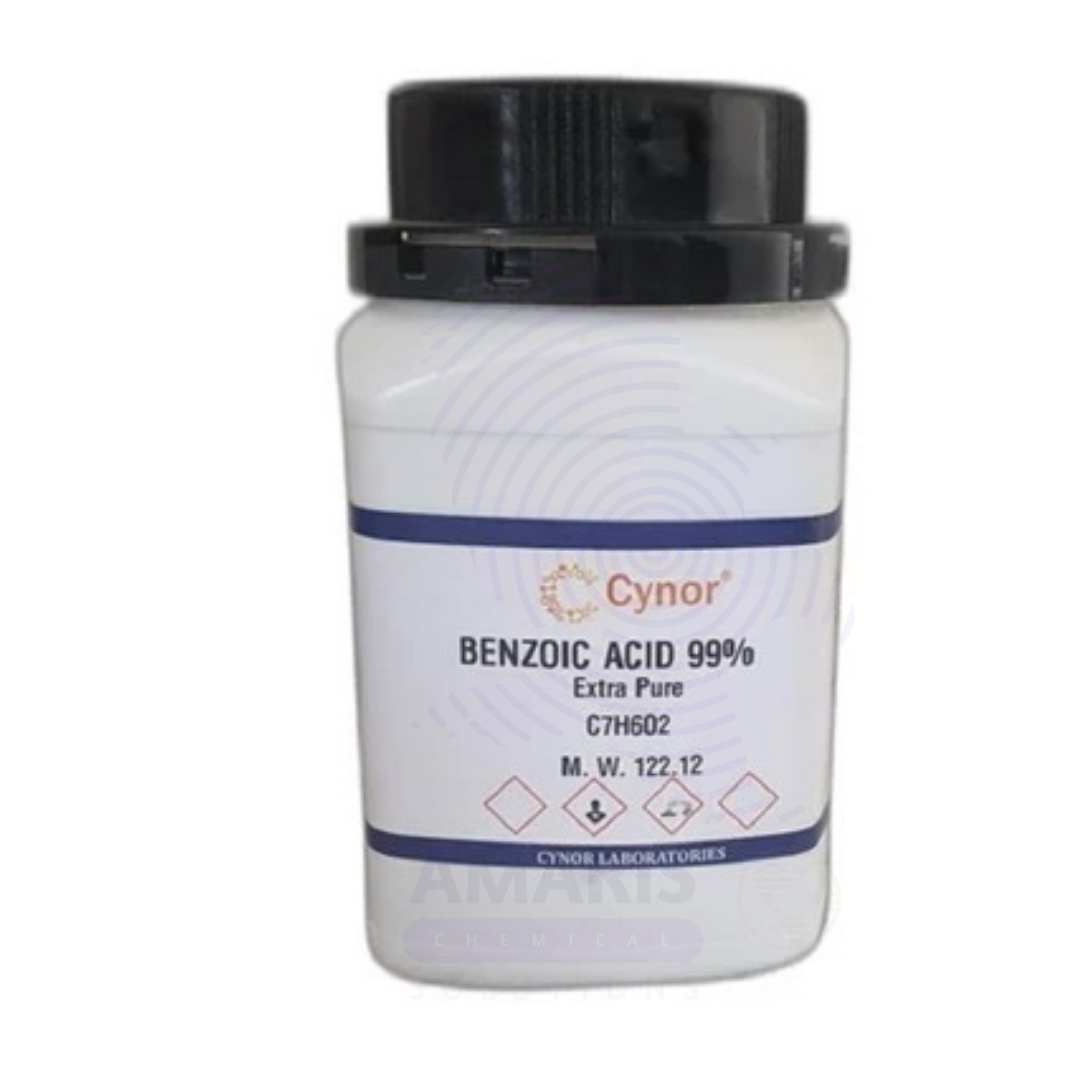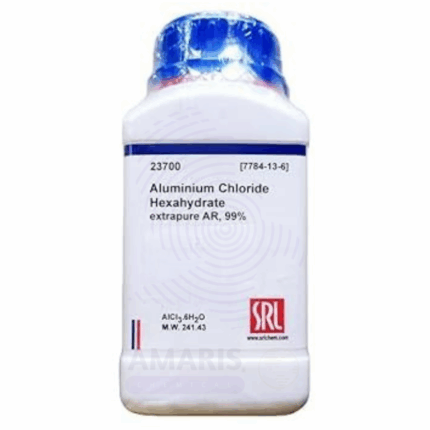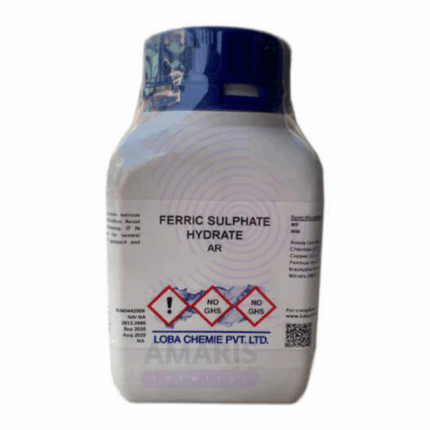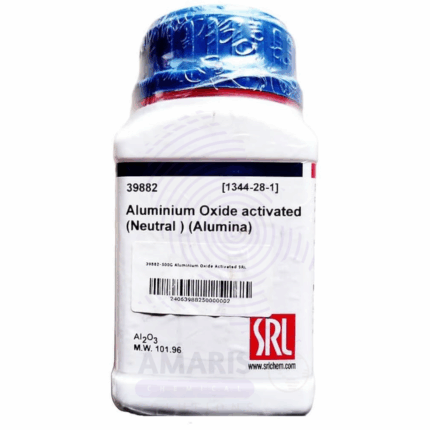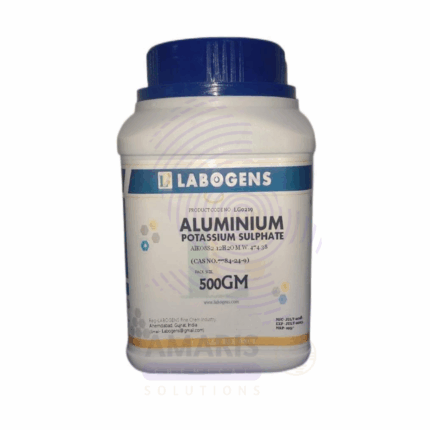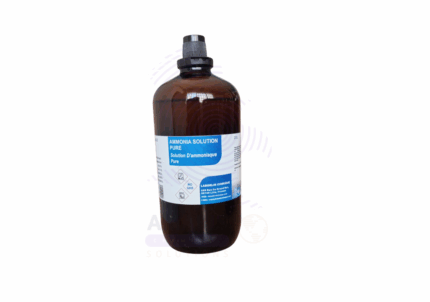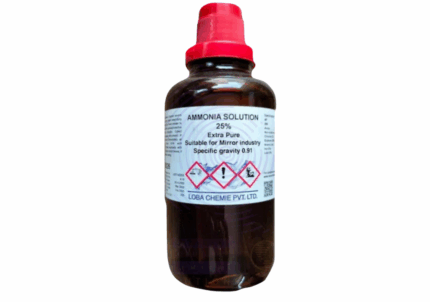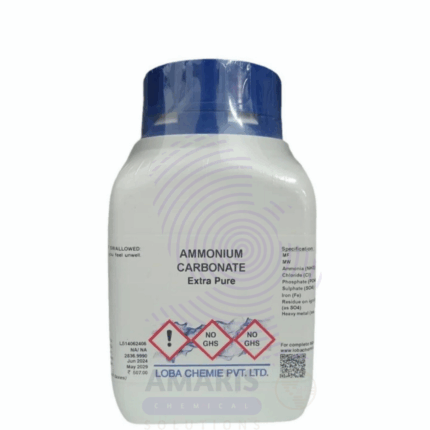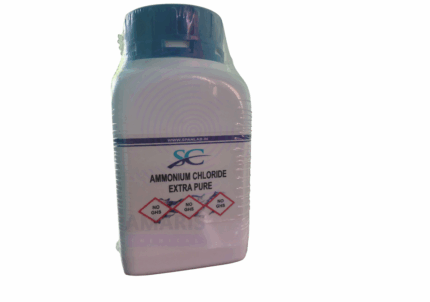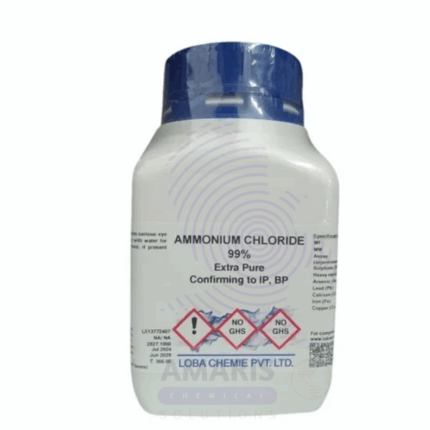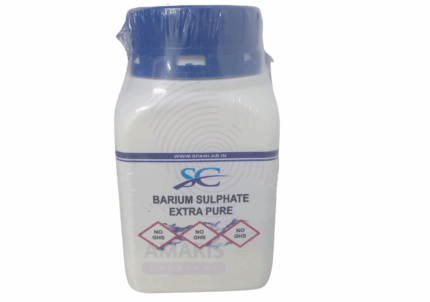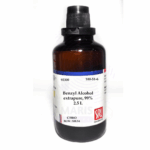
Benzoic Acid Extra Pure
$ 18.00 Original price was: $ 18.00.$ 17.67Current price is: $ 17.67.
Benzoic Acid Extra Pure is a high-purity, white crystalline solid widely used in laboratory chemistry for analytical, organic, and preparative applications. It serves as a fundamental compound in the study of carboxylic acids, esterification reactions, and recrystallization techniques. Its well-defined melting point and chemical stability make it ideal for calibration and thermal analysis. Additionally, benzoic acid is commonly employed as a preservative standard and in pH-buffering studies. The extra pure grade ensures minimal contamination, offering reliability and accuracy in high-precision experiments. It should be stored in a cool, dry place in a tightly sealed container, away from strong oxidizers.
Benzoic Acid Extra Pure
Primary Uses
- Standard for Calibration and Melting Point Determination
- Used as a melting point calibration substance due to its sharp melting point (~122°C).
- Also serves as a standard for acid-base titration or enthalpy of combustion experiments.
- Reagent in Organic Synthesis
- Acts as a precursor in synthesizing various esters, amides, and benzoyl derivatives in organic reaction studies and student experiments.
- Preparation of Benzoate Esters
- Used in esterification experiments (e.g., reaction with ethanol to form ethyl benzoate) to teach reaction mechanisms and purification techniques.
- Teaching Functional Group Identification
- Common in qualitative organic analysis to show carboxylic acid group reactions — such as salt formation, decarboxylation, or neutralization.
Secondary Uses
- Reference Compound in Thermochemical Studies
- In bomb calorimetry, benzoic acid is used as a calorimetric standard for determining heat of combustion.
- pH Studies and Buffer Systems
- In combination with its salt (sodium benzoate), it can be used to prepare buffer solutions for pH control in experiments.
- Crystallization and Purification Practice
- Frequently used in teaching recrystallization techniques, as it forms well-defined crystals and illustrates solubility behavior.
- Model for Substituted Aromatic Chemistry
- Its structure is used in studying substituent effects in aromatic systems (meta-/para- directing effects in EAS).
| PACK SIZE |
500 grams Plastic Tin |
|---|
1. Basic Identification Attributes
- Chemical Name: Benzoic Acid
- CAS Number: 65-85-0
- HS Code: 2916.31.00
- Molecular Formula: C₇H₆O₂
- Molar Mass: 122.12 g/mol
- Synonyms:
- Carboxybenzene
- Phenylformic acid
- Benzene carboxylic acid
2. Physical & Chemical Properties
- Physical State: Solid (crystalline powder)
- Color & Odor: White crystals or flakes with a faint pleasant odor
- Melting Point: 122.4 °C
- Boiling Point: 249.2 °C (with decomposition)
- Density: 1.265 g/cm³
- Solubility:
- In Water: Slightly soluble (3.4 g/L at 25 °C)
- Soluble in: Ethanol, ether, acetone, chloroform
- pKa (acid dissociation constant): ~4.2
- Vapor Pressure: Low (0.1 mmHg at 100 °C)
3. Safety & Hazard Attributes
- GHS Classification:
- Eye Irritation (Category 2A)
- Skin Irritation (Category 2)
- STOT – Single Exposure (Category 3, Respiratory tract irritation)
- NFPA Ratings:
- Health: 1
- Flammability: 1
- Reactivity: 0
- Exposure Limits:
- No established OSHA PEL or ACGIH TLV; handle with general lab safety practices
- Reactivity:
- Stable under recommended conditions
- Reacts with strong oxidizing agents and strong bases
4. Storage & Handling Attributes
- Storage Conditions:
- Store in tightly closed containers
- Cool, dry, well-ventilated area
- Incompatible Materials:
- Strong oxidizers, strong bases
- Container Type:
- HDPE bottles or amber glass jars for long-term storage
- Shelf Life:
- Stable for several years if stored properly
- Special Handling Requirements:
- Avoid inhalation of dust
- Use in fume hood if heating or weighing large quantities
- Wear lab coat, gloves, goggles
5. Regulatory & Compliance Attributes
- Regulatory Status:
- Listed under TSCA, REACH, and FDA (as a preservative, outside lab use)
- GHS Hazard Pictograms:
- UN Number: Not classified as hazardous for transport in small lab quantities
- Waste Disposal Method:
- Dispose via chemical waste program in accordance with local environmental regulations
6. Environmental & Health Impact
- Ecotoxicity:
- Harmful to aquatic life at high concentrations
- Biodegradability:
- Readily biodegradable
- Toxicological Note:
- Low acute toxicity
- May cause skin or eye irritation with prolonged exposure
SAFETY PRECAUTIONS
- Personal Protective Equipment (PPE):
- Wear lab coat, protective gloves (nitrile or neoprene), and safety goggles.
- Use a dust mask or work under a fume hood if handling large quantities of powder.
- Handling:
- Avoid inhaling dust or fumes.
- Prevent contact with eyes and skin.
- Handle with care to avoid spills and airborne particles.
- Storage:
- Store in a cool, dry, well-ventilated area.
- Keep the container tightly closed and away from strong oxidizers and moisture.
- Hygiene Measures:
- Wash hands thoroughly after handling.
- Do not eat, drink, or smoke in the lab during handling.
FIRST AID MEASURES
- Inhalation:
- Move to fresh air immediately.
- Seek medical attention if respiratory irritation persists.
- Skin Contact:
- Wash thoroughly with soap and water.
- Remove contaminated clothing.
- Eye Contact:
- Rinse cautiously with water for at least 15 minutes.
- Seek medical help if irritation continues.
- Ingestion:
- Rinse mouth.
- Do not induce vomiting unless instructed by medical personnel.
- Seek medical advice promptly.
FIRE FIGHTING MEASURES
- Extinguishing Media:
- Use water spray, dry chemical, foam, or carbon dioxide (CO₂).
- Fire Hazards:
- Combustible solid; may emit irritating or toxic fumes (carbon monoxide/dioxide) when burned.
- Fine dust may form explosive mixtures in air.
- Protective Equipment:
- Wear self-contained breathing apparatus (SCBA) and fire-resistant clothing.
- Firefighting Instructions:
- Cool surrounding containers with water.
- Avoid letting water runoff contaminate the environment.
Related products
Aluminium Chloride Hydrated Extra Pure
Aluminium Ferric Sulphate Extra Pure
Aluminium Oxide Active Neutral Extra Pure
Aluminium Potassium Sulphate Hydrated Extra Pure
Ammonia Solution Extra Pure
Ammonium Carbonate Extra Pure
Ammonium Carbonate Extra Pure is a high-quality, white crystalline solid widely used across various scientific, industrial, and food-related applications. Manufactured to stringent purity standards, this compound is ideal for laboratories and processes that demand high-grade reagents. With its characteristic ammonia-like odor and ability to decompose upon heating, ammonium carbonate plays a versatile role in both chemical reactions and physical processes.
In aqueous solution, ammonium carbonate breaks down into ammonium bicarbonate and ammonium carbamate, further releasing ammonia (NH₃) and carbon dioxide (CO₂) upon heating. This property makes it especially useful in applications that require controlled gas release or temporary pH modification.


 Preservatives(food)
Preservatives(food) Flavor Enhancers
Flavor Enhancers Acidulants
Acidulants Sweeteners
Sweeteners Antioxidants
Antioxidants Colorants(food)
Colorants(food) Nutraceutical Ingredients (food)
Nutraceutical Ingredients (food) Nutrient Supplements
Nutrient Supplements Emulsifiers
Emulsifiers
 Collectors
Collectors Dust Suppressants
Dust Suppressants Explosives and Blasting Agents
Explosives and Blasting Agents Flocculants and Coagulants
Flocculants and Coagulants Frothers
Frothers Leaching Agents
Leaching Agents pH Modifiers
pH Modifiers Precious Metal Extraction Agents
Precious Metal Extraction Agents
 Antioxidants(plastic)
Antioxidants(plastic) Colorants (Pigments, Dyes)
Colorants (Pigments, Dyes) Fillers and Reinforcements
Fillers and Reinforcements Flame Retardants
Flame Retardants Monomers
Monomers Plasticizers
Plasticizers Polymerization Initiators
Polymerization Initiators Stabilizers (UV, Heat)
Stabilizers (UV, Heat)
 Antifoaming Agents
Antifoaming Agents Chelating Agents
Chelating Agents Coagulants and Flocculants
Coagulants and Flocculants Corrosion Inhibitors
Corrosion Inhibitors Disinfectants and Biocides
Disinfectants and Biocides Oxidizing Agents
Oxidizing Agents pH Adjusters
pH Adjusters Scale Inhibitors( water)
Scale Inhibitors( water)
 Antioxidants(cosmetic)
Antioxidants(cosmetic) Emollients
Emollients Fragrances and Essential Oils
Fragrances and Essential Oils Humectants
Humectants Preservatives
Preservatives Surfactants(cosmetic)
Surfactants(cosmetic) Thickeners
Thickeners UV Filters
UV Filters
 Fertilizers
Fertilizers Soil Conditioners
Soil Conditioners Plant Growth Regulators
Plant Growth Regulators Animal Feed Additives
Animal Feed Additives Biostimulants
Biostimulants Pesticides (Herbicides, Insecticides, Fungicides)
Pesticides (Herbicides, Insecticides, Fungicides)
 Active Pharmaceutical Ingredients (APIs)
Active Pharmaceutical Ingredients (APIs) Excipients
Excipients Solvents(pharmaceutical)
Solvents(pharmaceutical) Antibiotics
Antibiotics Antiseptics and Disinfectants
Antiseptics and Disinfectants Vaccine Adjuvants
Vaccine Adjuvants Nutraceutical Ingredients (pharmaceutical)
Nutraceutical Ingredients (pharmaceutical) Analgesics & Antipyretics
Analgesics & Antipyretics
 Analytical Reagents
Analytical Reagents Solvents(lab)
Solvents(lab) Chromatography Chemicals
Chromatography Chemicals Spectroscopy Reagents
Spectroscopy Reagents microbiology-and-cell-culture-reagents
microbiology-and-cell-culture-reagents Molecular Biology Reagents
Molecular Biology Reagents Biochemical Reagents
Biochemical Reagents Inorganic and Organic Standards
Inorganic and Organic Standards Laboratory Safety Chemicals
Laboratory Safety Chemicals Specialty Laboratory Chemicals(Special Laboratory Equipment)
Specialty Laboratory Chemicals(Special Laboratory Equipment)
 Demulsifiers
Demulsifiers Hydraulic Fracturing Fluids
Hydraulic Fracturing Fluids Scale Inhibitors(oil)
Scale Inhibitors(oil) Surfactants(oil)
Surfactants(oil) Drilling Fluids
Drilling Fluids
 Dyes and Pigments
Dyes and Pigments Bleaching Agents
Bleaching Agents Softening Agents
Softening Agents Finishing Agents
Finishing Agents Antistatic Agents
Antistatic Agents
 Admixtures
Admixtures Waterproofing Agents
Waterproofing Agents Sealants and Adhesives
Sealants and Adhesives Curing Compounds
Curing Compounds Concrete Repair Chemicals
Concrete Repair Chemicals Anti-Corrosion Coatings
Anti-Corrosion Coatings
 Surfactants(cleaning)
Surfactants(cleaning) Builders
Builders Enzymes
Enzymes Solvents (Cleaning)
Solvents (Cleaning) Fragrances
Fragrances
 Electronic Chemicals
Electronic Chemicals Catalysts
Catalysts Lubricants
Lubricants Photographic Chemicals
Photographic Chemicals Refrigerants
Refrigerants Automotive chemicals
Automotive chemicals Pyrotechnic Chemicals
Pyrotechnic Chemicals
 Biodegradable Surfactants
Biodegradable Surfactants Bio-based Solvents
Bio-based Solvents Renewable Polymers
Renewable Polymers Carbon Capture Chemicals
Carbon Capture Chemicals Wastewater Treatment Chemicals
Wastewater Treatment Chemicals
 Pigments
Pigments Solvents(paint)
Solvents(paint) Specialty Coatings
Specialty Coatings Binders/Resins
Binders/Resins Additives
Additives Driers
Driers Anti-Corrosion Agents
Anti-Corrosion Agents Functional Coatings
Functional Coatings Application-Specific Coatings
Application-Specific Coatings
 Fresh Herbs
Fresh Herbs Ground Spices
Ground Spices Whole Spices
Whole Spices Spice Blends
Spice Blends Dried Herbs
Dried Herbs
 Leavening Agents
Leavening Agents Dough Conditioners
Dough Conditioners Flour Treatments
Flour Treatments Fat Replacers
Fat Replacers Decoratives
Decoratives Preservatives(baking)
Preservatives(baking)
 Plasticizers & Softeners
Plasticizers & Softeners Reinforcing Agents
Reinforcing Agents Adhesion Promoters
Adhesion Promoters Vulcanizing Agents
Vulcanizing Agents Antidegradants
Antidegradants Blowing Agents
Blowing Agents Fillers & Extenders
Fillers & Extenders Accelerators & Retarders
Accelerators & Retarders